Story and photos by Shabna Ullah
Edinburgh, East Bank Berbice is located five miles from New Amsterdam but the time and effort to manoeuvre around huge potholes to get there makes the distance seem much longer.
With a mixed population of almost 2,000, Edinburgh is divided into two sections; one is known as the ‘village’ and the other which was surveyed in 1953, is referred to as ‘the scheme.’ On the opposite side is the New Glasgow Housing Scheme which is run by the New Amsterdam Town Council.

during the school break
The tranquillity was often interrupted by vehicles dropping unavoidably into the potholes as they passed through the village. This newspaper looked on as drivers tried to dodge the holes and even drove onto the parapet which has already started to be destroyed.
There was hardly a good spot to traverse and residents bemoaned the deplorable condition that the road had been reduced to. The potholes not only cause damage to tyres, they said, but the road is not safe, even for pedestrians. They related that just recently a child fell on a bad section of the road while returning home from school. They ran to the child’s assistance and were thankful that no vehicle was coming at the time.
Forming part of the landscape of the village are the primary school; the Enfield/New Doe Park Neighbour-hood Democratic Council (NDC) that is housed below the sports club and pavilion; a playground; a health centre; churches; workshop; liquor restaurants; grocery shops; a hardware store; and a Digicel tower.
The NDC provides a free garbage collection service to residents on a weekly basis using its tractor-trailer. An official from the NDC said residents may sometimes experience delays when the tractor is engaged in other work. The NDC’s backhoe is used for drainage work.
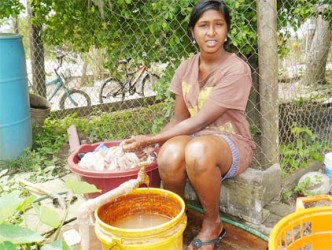
Most of the residents are employed at the Providence estate as labourers and cane-harvesters, and some have found work at the cement factory in the neighbouring village of Everton.
The village has also produced teachers, nurses, hairdressers and an aspiring doctor − 19-year-old Andrew Cameron. He was one of four Guyanese who were chosen to study medicine at the St Helen University in St Lucia.
He left in January to begin his studies.
His aunt, Shivon August, said proudly that her nephew saw the advertisement for the scholarship in the newspapers and applied. He was elated that he was accepted and granted a 50% scholarship. A former student of New Amsterdam Multilateral, Andrew had also performed well at the Caribbean Advanced Proficiency Examination. His mother works as a staff nurse/midwife and as a ward sister at the New Amsterdam Hospital.
Audrey August, another aunt, said the village needs skills training classes so the youths
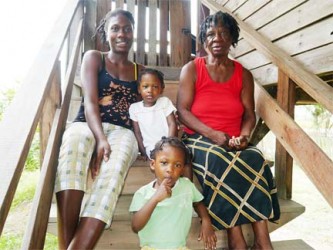
can be occupied in a positive way. She works as a cook at Jokwassan’s restaurant in New Amsterdam. She developed her talent for cooking fancy dishes and baking at a home economics class at the Institute of Distance and Continuing Education (IDCE) in the ’80s.
Her son, Rawle Adams, is a foreman at the Rose Hall Estate and her daughter, Rochelle Adams, is pursuing business studies.
Youths in the village had benefited from the Citizens’ Security Programme where they got the opportunity to learn various skills. Audrey, whose niece had done a hairdressing course with the IDCE is sorry that the classes are no longer being held.
At the school located at the entrance to the village, students were on their mid-morning break.

Some were enjoying the food they purchased from the snackettes in the school yard while others were playing. Three little girls posed with their icicles as this newspaper took their photo. A little boy went with a bag to the house near the school to purchase ice, but the owner was not at home.
He then went next door to Verley Fullerton’s house where she sold him the ice.
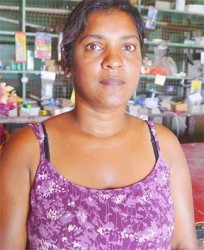
Verley, a security guard employed with Kanhai’s security company for the past 12 years is based at the primary school. She works from 4 pm to midnight. She was concerned that the company takes a long time to pay salaries and hoped that the situation would improve. She said the problem was affecting all the workers and is causing a lot of inconvenience because they have bills to pay and homes to run.
The woman does not socialize too much with residents and said when she is at home her time is taken up with her grandchildren and doing chores. Her daughter-in-law, Jewel Francis sat on the stairs with her two-year-old twin daughters. An older child was at nursery school. Jewel’s husband works as a cane-harvester and she is seeking a job to supplement his income. She worked before as a telemarketer and a security dispatcher, and has sent out applications in search of another job.
Improvement

Apart from the road being a big issue, residents were “happy with the other improvements; we used to have difficulty in accessing water but we have a regular supply now, stable electricity and the crime rate has reduced,” this newspaper was told. They wonder though, if government has any plans to fix the road at all because of the long time they have been waiting. It is sad to see it deteriorating like that, they reiterated. The road falls under the Ministry of Public Works and residents said they were “fed up with the patch work every time. They spending millions of dollars to patch the road and it still gets bad. Government needs to build a new road.”
Heeralall Sasenarine, who engages in tyre repairs and part-time welding, said the road is actually resulting in poor business for him. “Hire car drivers cannot afford the new tyres so they purchase the second-hand ones which damage faster. When they drop in the potholes, they cut or bend the tyres,” he lamented. “So instead of repairing, the drivers have to change the tyres.”
He looked around impatiently that day as he waited for work, and when this newspaper commented jokingly that at least he had a free day, he said it was actually a “stress day…”
In spite of that, he too is “happy for the development in the village. I am not affiliated with any political party; all I want is to have progress, for the road to be fixed.”
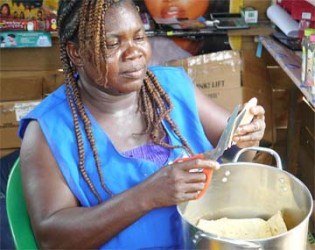
He does not depend on the workshop alone and is engaged in cash crop farming. But he is experiencing challenges with that too because “cows would destroy the crops.” According to him, there is “no justice when cows destroy my farm; you cannot even go close to them to see the brand…” He fenced his farm with barbed wire but the cows still manage to get in.
He said “farmers had a place on the East Bank for the cows to graze but government approved 2000 acres of land to one rice farmer from the Corentyne. Most of the people had to give up cattle farming.”
He has been training some young boys in the village to weld, “whenever they have to time to come around” and said it is better for them to learn a trade than “being on the street.”
Residents were concerned that “some unemployed youths would be consuming alcohol all day.” They said too that there are persons who would also “sell marijuana and encourage schoolchildren to use it. Police got reports but they are not doing anything about it.”
Nearby, 15-year-old Maduri ‘Jennifer’ Ramkission was sitting by the standpipe in her yard doing laundry when this newspaper dropped in. She also assists with household chores.
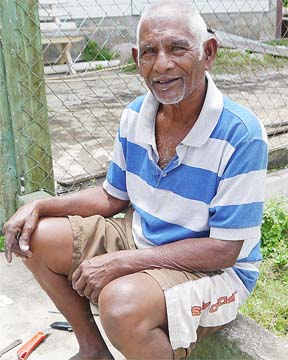
The former student of the Overwinning school has been living with her aunt and uncle since her parents died. Her uncle Ramesh Ramkissoon who was also busy in the yard does “miscellaneous work” at the estate during the night shift.
Across the road, Donette Wilburgh waits on customers at her snackette. She lived in the village for a few years before moving to the New Glasgow Housing Scheme. Donette makes mittai, sugar cake, plantain chips, ‘gata’ candies, nut-crush, tamarind balls, fudge and ‘badam latcha’ to sell. Her customers also look forward to her gooseberry jam and mango jam that she makes by boiling them with cinnamon, cloves, sugar and red colouring. She likes to keep herself occupied and started to cut her pre-prepared salt-siew while waiting on customers.
Next to her stall, her daughter Francina Alexander operates a hair salon and cosmetic shop, selling mostly African hair products. She opened the business a month ago.
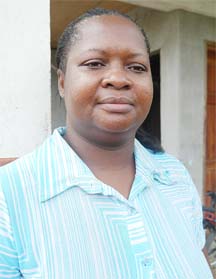
At the hardware store, Tarawattie Amardeo, a single mother of 14 and 15-year-old children, said she “trying to survive on the business” which was not too bright. It was her only means of earning an income and she was finding it difficult to restock the store because the items were “too expensive.”
Nizam Bacchus was encountered leaving another shop with a pack of corn curls in his hands. He was on his way to pick up his granddaughter from school and was taking the snacks for her. The father of seven worked as a cane-harvester but suffered a stroke in 2005 and had to quit.
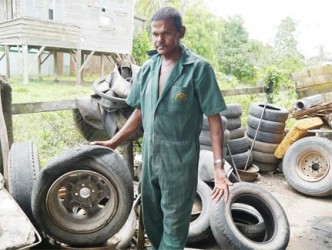
Down in the scheme, Mohamed Naseer, 77, was sitting on his bridge sharpening some knives. He was happy when this newspaper stopped to talk to him. He likes to keep himself busy and would tend to his kitchen garden and rear chickens at times. He was born at Plantation Friends and attended the Church of Scotland School in that village. He moved to Edinburgh in 1961 after his father-in-law gave him a plot of land.
Mohamed said he worked for a short time on the sugar estate “doing different jobs.” He also started working as a labourer at the Everton plant in 1967 and he became a foreman in 1985.




